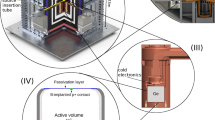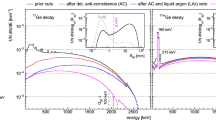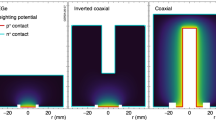Abstract
The GERmanium Detector Array (Gerda) experiment at the Gran Sasso underground laboratory (LNGS) of INFN is searching for neutrinoless double-beta (0νββ) decay of 76Ge. The technological challenge of Gerda is to operate in a “background-free” regime in the region of interest (ROI) after analysis cuts for the full 100 kg·yr target exposure of the experiment. A careful modeling and decomposition of the full-range energy spectrum is essential to predict the shape and composition of events in the ROI around Qββ for the 0νββ search, to extract a precise measurement of the half-life of the double-beta decay mode with neutrinos (2νββ) and in order to identify the location of residual impurities. The latter will permit future experiments to build strategies in order to further lower the background and achieve even better sensitivities. In this article the background decomposition prior to analysis cuts is presented for Gerda Phase II. The background model fit yields a flat spectrum in the ROI with a background index (BI) of \( {16.04}_{-0.85}^{+0.78}\cdotp {10}^{-3} \) cts/(keV·kg·yr) for the enriched BEGe data set and \( {14.68}_{-0.52}^{+0.47}\cdotp {10}^{-3} \) cts/(keV·kg·yr) for the enriched coaxial data set. These values are similar to the one of Phase I despite a much larger number of detectors and hence radioactive hardware components.

Article PDF
Similar content being viewed by others
References
R.N. Mohapatra and A.Y. Smirnov, Neutrino Mass and New Physics, Ann. Rev. Nucl. Part. Sci. 56 (2006) 569 [hep-ph/0603118] [INSPIRE].
R.N. Mohapatra et al., Theory of neutrinos: A White paper, Rept. Prog. Phys. 70 (2007) 1757 [hep-ph/0510213] [INSPIRE].
H. Päs and W. Rodejohann, Neutrinoless double beta decay, New J. Phys. 17 (2015) 115010.
Gerda collaboration, The Gerda experiment for the search of 0νββ decay in 76 Ge, Eur. Phys. J. C 73 (2013) 2330 [arXiv:1212.4067] [INSPIRE].
Gerda collaboration, Upgrade for Phase II of the Gerda experiment, Eur. Phys. J. C 78 (2018) 388 [arXiv:1711.01452] [INSPIRE].
B.J. Mount, M. Redshaw and E.G. Myers, Double-β-decay Q values of 74Se and 76Ge, Phys. Rev. C 81 (2010) 032501 [INSPIRE].
Gerda collaboration, Background-free search for neutrinoless double-β decay of 76Ge with Gerda, Nature 544 (2017) 47 [arXiv:1703.00570] [INSPIRE].
Gerda collaboration, Improved Limit on Neutrinoless Double-β Decay of 76Ge from Gerda Phase II, Phys. Rev. Lett. 120 (2018) 132503 [arXiv:1803.11100] [INSPIRE].
Gerda collaboration, Probing Majorana neutrinos with double-β decay, Science 365 (2019) 1445 [arXiv:1909.02726] [INSPIRE].
Gerda collaboration, Pulse shape discrimination for Gerda Phase I data, Eur. Phys. J. C 73 (2013) 2583 [arXiv:1307.2610] [INSPIRE].
A. Lubashevskiy et al., Mitigation of 42Ar/42K background for the Gerda Phase II experiment, Eur. Phys. J. C 78 (2018) 15 [arXiv:1708.00226] [INSPIRE].
Gerda collaboration, Production, characterization and operation of 76Ge enriched BEGe detectors in Gerda, Eur. Phys. J. C 75 (2015) 39 [arXiv:1410.0853] [INSPIRE].
Gerda collaboration, Characterization of 30 76Ge enriched Broad Energy Ge detectors for Gerda Phase II, Eur. Phys. J. C 79 (2019) 978 [arXiv:1901.06590] [INSPIRE].
Gerda collaboration, The background in the 0νββ experiment Gerda, Eur. Phys. J. C 74 (2014) 2764 [arXiv:1306.5084] [INSPIRE].
L. Vanhoefer, Limitations of Rare Event HPGe Experiments due to Muon-Induced Neutron Background, Ph.D. Thesis, Technische Universität München (2018).
Gerda collaboration, Improvement of the energy resolution via an optimized digital signal processing in Gerda Phase I, Eur. Phys. J. C 75 (2015) 255 [arXiv:1502.04392] [INSPIRE].
T. Wester, Characterization of coincidence data of the Gerda experiment to search for double beta decays to excited states, Ph.D. Thesis, Technische Universität Dresden (2019).
M. Boswell et al., MaGe — a Geant4-Based Monte Carlo Application Framework for Low-Background Germanium Experiments, IEEE Trans. Nucl. Sci. 58 (2011) 1212.
Geant4 collaboration, Geant4: A Simulation toolkit, Nucl. Instrum. Meth. A 506 (2003) 250 [INSPIRE].
J. Allison et al., Geant4 developments and applications, IEEE Trans. Nucl. Sci. 53 (2006) 270.
J. Allison et al., Recent developments in Geant4, Nucl. Instrum. Meth. A 835 (2016) 186 [INSPIRE].
V. Tretyak and Y. Zdesenko, Tables of double beta decay data, Atom. Data Nucl. Data Tabl. 61 (1995) 43.
O.A. Ponkratenko, V.I. Tretyak and Y.G. Zdesenko, The Event generator DECAY4 for simulation of double beta processes and decay of radioactive nuclei, Phys. Atom. Nucl. 63 (2000) 1282 [nucl-ex/0104018] [INSPIRE].
M.L. di Vacri et al., ICP MS selection of radiopure materials for the Gerda experiment, AIP Conf. Proc. 1672 (2015) 150001 [INSPIRE].
G. Meierhofer, P. Kudejova, L. Canella, P. Grabmayr, J. Jochum and J. Jolie, Thermal neutron capture cross-section of 76Ge, Eur. Phys. J. A 40 (2009) 61.
G. Meierhofer, P. Grabmayr, J. Jochum, P. Kudejova, L. Canella and J. Jolie, Thermal neutron capture cross section of 74Ge, Phys. Rev. C 81 (2010) 027603 [INSPIRE].
G. Meierhofer, P. Grabmayr, L. Canella, P. Kudejova, J. Jolie and N. Warr, Prompt γ rays in 77Ge and 75Ge after thermal neutron capture, Eur. Phys. J. A 48 (2012) 20 [INSPIRE].
H.V. Klapdor-Kleingrothaus et al., Latest results from the Heidelberg-Moscow double beta decay experiment, Eur. Phys. J. A 12 (2001) 147 [hep-ph/0103062] [INSPIRE].
IGEX collaboration, The IGEX 76Ge neutrinoless double beta decay experiment: Prospects for next generation experiments, Phys. Rev. D 65 (2002) 092007 [hep-ex/0202026] [INSPIRE].
Gerda collaboration, Limits on uranium and thorium bulk content in Gerda Phase I detectors, Astropart. Phys. 91 (2017) 15 [arXiv:1611.06884] [INSPIRE].
K. Freund, Muonic Background in the Gerda 0νββ Experiment, Ph.D. Thesis, Eberhard Karls Universität Tübingen (2014).
C. Wiesinger, L. Pandola and S. Schönert, Virtual depth by active background suppression: Revisiting the cosmic muon induced background of Gerda Phase II, Eur. Phys. J. C 78 (2018) 597 [arXiv:1802.05040] [INSPIRE].
I. Barabanov et al., Shielding of the Gerda experiment against external gamma background, Nucl. Instrum. Meth. A 606 (2009) 790 [INSPIRE].
D.M. Mei, S.R. Elliott, A. Hime, V. Gehman and K. Kazkaz, Neutron inelastic scattering processes as a background for double-beta decay experiments, Phys. Rev. C 77 (2008) 054614 [arXiv:0704.0306] [INSPIRE].
K. Winger, J. Feichter, M. Kalinowski, H. Sartorius and C. Schlosser, A new compilation of the atmospheric 85Krypton inventories from 1945 to 2000 and its evaluation in a global transport model, J. Environ. Radioactiv. 80 (2005) 183.
A. Caldwell, D. Kollár and K. Kröninger, BAT: The Bayesian Analysis Toolkit, Comput. Phys. Commun. 180 (2009) 2197 [arXiv:0808.2552] [INSPIRE].
F. Beaujean, A. Caldwell, D. Greenwald, K. Kröninger and O. Schulz, BAT release, version 1.0.0, https://doi.org/10.5281/zenodo.1322675 (2018).
F. Beaujean, A. Caldwell, D. Kollár and K. Kröninger, p-values for model evaluation, Phys. Rev. D 83 (2011) 012004 [arXiv:1011.1674].
B. Lehnert, Search for 2νββ Excited State Transitions and HPGe Characterization for Surface Events in Gerda Phase II, Ph.D. Thesis, Technische Universität Dresden (2016).
R. Aggarwal and A. Caldwell, Error bars for distributions of numbers of events, Eur. Phys. J. Plus. 127 (2012) 24.
Gerda collaboration, Results on Neutrinoless Double-β Decay of 76Ge from Phase I of the Gerda Experiment, Phys. Rev. Lett. 111 (2013) 122503 [arXiv:1307.4720] [INSPIRE].
Gerda collaboration, Measurement of the half-life of the two-neutrino double beta decay of 76Ge with the Gerda experiment, J. Phys. G 40 (2013) 035110 [arXiv:1212.3210] [INSPIRE].
Gerda collaboration, Results on ββ decay with emission of two neutrinos or Majorons in 76Ge from Gerda Phase I, Eur. Phys. J. C 75 (2015) 416 [arXiv:1501.02345] [INSPIRE].
J.S. Díaz, Limits on Lorentz and CPT violation from double beta decay, Phys. Rev. D 89 (2014) 036002 [arXiv:1311.0930] [INSPIRE].
LEGEND collaboration, The Large Enriched Germanium Experiment for Neutrinoless Double Beta Decay (LEGEND), AIP Conf. Proc. 1894 (2017) 020027 [arXiv:1709.01980] [INSPIRE].
V. D’Andrea, Improvement of Performance and Background Studies in Gerda Phase II, Ph.D. Thesis, Gran Sasso Science Institute (GSSI) (2017).
M.Z.M.J. Berger, J.S. Coursey and J. Chang, Stopping-Power & Range Tables for Electrons, Protons, and Helium Ions, NIST Standard Reference Database 124 (2017) .
M.-M. Bé et al., Table of Radionuclides, vol. 4 of Monographie BIPM-5, Bureau International des Poids et Mesures, Pavillon de Breteuil, F-92310 Sèvres, France (2008).
M. Agostini, Signal and background studies for the search of neutrinoless double beta decay in Gerda, Ph.D. Thesis, TechnischeV Universität München (2013).
B.T. Cleveland, The analysis of radioactive decay with a small number of counts by the method of maximum likelihood, Nucl. Instrum. Meth. 214 (1983) 451 [INSPIRE].
Open Access
This article is distributed under the terms of the Creative Commons Attribution License (CC-BY 4.0), which permits any use, distribution and reproduction in any medium, provided the original author(s) and source are credited
Author information
Authors and Affiliations
Consortia
Corresponding author
Additional information
ArXiv ePrint: 1909.02522
Deceased (V. Egorov)
Rights and permissions
Open Access . This article is distributed under the terms of the Creative Commons Attribution License (CC-BY 4.0), which permits any use, distribution and reproduction in any medium, provided the original author(s) and source are credited.
About this article
Cite this article
The GERDA collaboration., Agostini, M., Bakalyarov, A.M. et al. Modeling of GERDA Phase II data. J. High Energ. Phys. 2020, 139 (2020). https://doi.org/10.1007/JHEP03(2020)139
Received:
Revised:
Accepted:
Published:
DOI: https://doi.org/10.1007/JHEP03(2020)139




